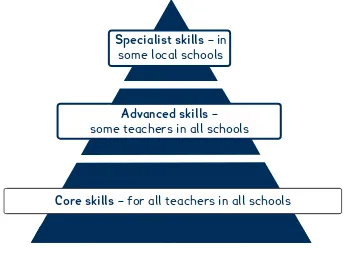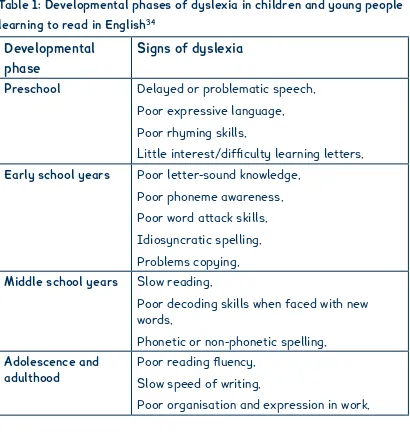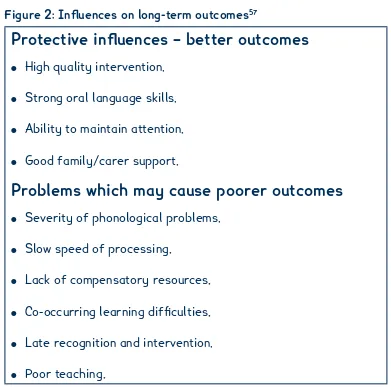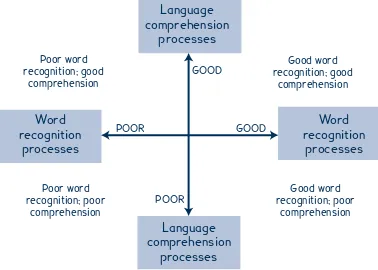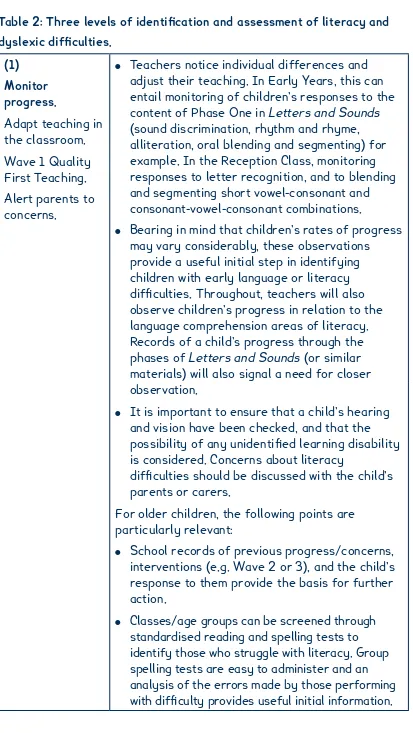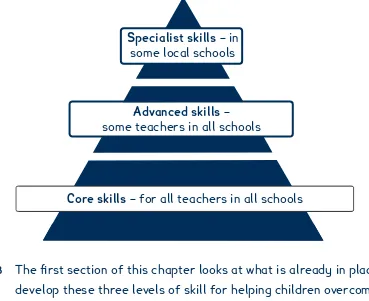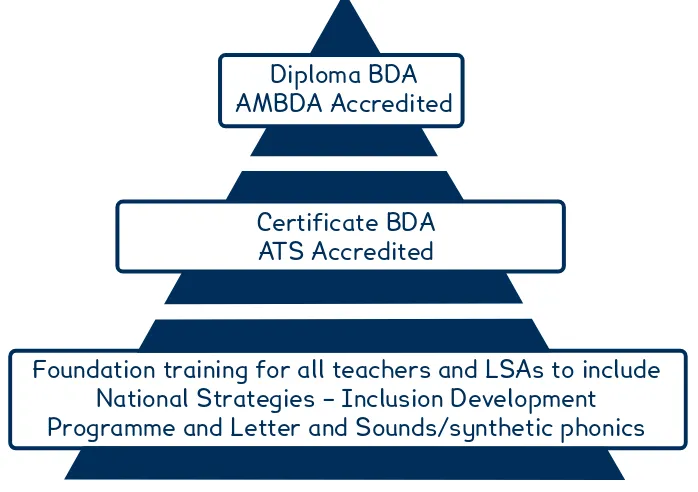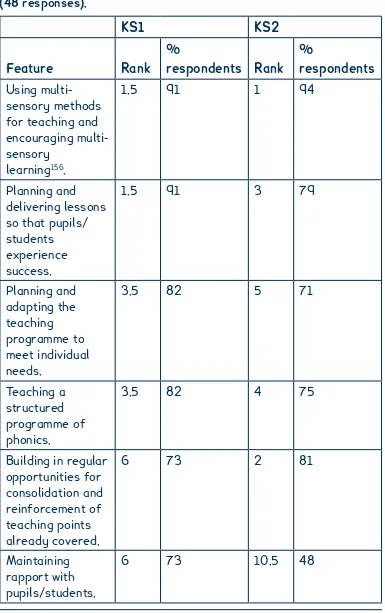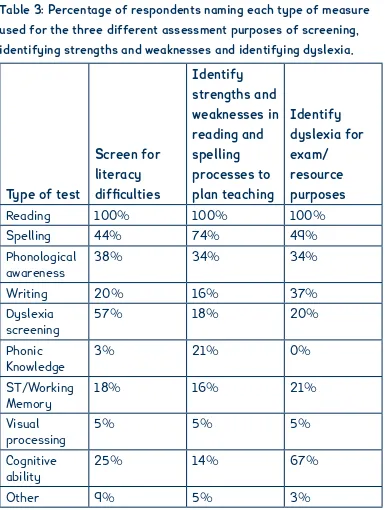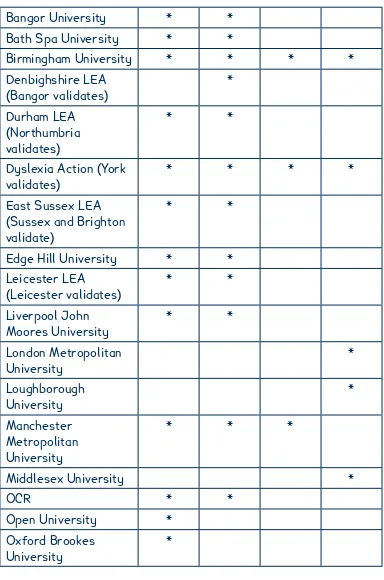Identifying and Teaching Children
and Young People with Dyslexia
and Literacy Difficulties
An independent report from Sir Jim Rose to the
Secretary of State for Children, Schools and Families
June 2009
and
Teaching Children and
Y
oung
People
with
Dyslexia and Literacy
Difficulties
You can download this publication or order copies online at
www.teachernet.gov.uk/publications
Search using ref: DCSF-00659-2009
Copies of this publication can be obtained from: DCSF Publications
PO Box 5050 Sherwood Park Annesley
Nottingham NG15 0DJ Tel: 0845 60 222 60 Fax: 0845 60 333 60
Textphone: 0845 60 555 60
Please quote the ref: 00659-2009DOM-EN ISBN: 978-1-84775-471-4
D16(8169)/0609/53 © Crown copyright 2009
and Young People with Dyslexia
and Literacy Difficulties
An independent report from Sir Jim Rose to the
Secretary of State for Children, Schools and Families
June 2009
A note on terminology
Letter to the Secretary
of State from Sir Jim Rose
Dear Secretary of StateThis is the review of dyslexia which you invited me to undertake in May 2008. The remit for the review, on which a call for evidence was launched on 14 July 20081, is set out below. The call for
evidence resulted in 863 responses2, which when added to our
reviews of research literature, wide consultation and school visits, provided a considerable database for this report.
The Children’s Plan3 made it clear that the Government wants every
child to succeed, and it hardly needs to be said that the ability to read well is key to success in education and an essential ‘life skill’. Moreover, reading and writing are closely related, and both are dependent on the development of children’s speaking and listening capabilities. As the review explains, responses to overcoming dyslexia and other developmental difficulties of language learning and cognition must be robust and set within high quality provision for securing literacy for all children, especially in primary schools.
It is important to develop high quality interventions for children with literacy and dyslexic difficulties and to implement them thoroughly. This will require well trained, knowledgeable teachers and support staff. It is therefore recommended that the
Department for Children, Schools and Families (DCSF) should
1 Weblink to DCSF Press Notice announcing call for evidence
www.dcsf.gov.uk/pns/DisplayPN.cgi?pn_id=2008_0148
2 659 responses were from parents or carers of children with
commission short courses for teachers on selecting and teaching literacy intervention programmes.
Although well-founded interventions enable most children to make progress, those with the most severe difficulties invariably require more specialist support. It is therefore also recommended that the DCSF should fund a number of teachers to undertake specialist training in teaching children with dyslexia so that access to specialist expertise can be improved across local authorities and schools will form partnerships to share expertise.
Reading disorders have been extensively researched such that dyslexia, the existence of which was once questioned, is now widely recognised as a specific difficulty in learning to read. Research also shows that dyslexia may affect more than the ability to read and write. There is a growing body of research on so-called
‘co-occurring’ factors. While these factors are discussed, the report is mainly concerned with identifying and responding directly to
counter the effects of dyslexia on literacy. This is clearly the main concern of anxious parents about the adequacy of school provision to help their children overcome dyslexia, as the following comment from a parent shows:
‘I gave up on her school. I was literally banging my head on a brick wall. Everyone knew she couldn’t read to save her life and that’s what was causing all her other problems, especially at home, it was a nightmare.’
The British Dyslexia Association (BDA) reports that its helpline receives calls from many parents with similar concerns. Whether real or perceived, it is often a sense of lack of urgency in the system for taking action to provide for the child that causes parental anxiety. Obviously, this anxiety is heightened if
bureaucratic processes appear to grind slow in providing effective interventions to help children overcome dyslexic difficulties.
commended by parents. How best to even up the quality of
provision and eradicate unacceptable variations in the time taken to implement it are therefore recurring themes of this review.
While there are no ‘quick fixes’, research and best practice converge on the principles that define effective provision for children with dyslexia and the kinds of support schools need to implement and sustain such provision.
I hope the review will therefore help policy makers and providers to strengthen practice, and assure parents that provision for children with dyslexia will be as good as we can make it.
The report owes much to the depth and range of knowledge of its Expert Advisory Group, and to the many groups and individuals who have contributed fulsomely through the call for evidence,
consultations and school visits. I am most grateful to all those concerned and for the excellent support of my secretariat.
Yours sincerely,
Expert Advisory Group
Members of the Expert Advisory Group:
Professor Greg Brooks, now retired, formerly at the School of Education, University of Sheffield
Professor Robert Burden, School of Education, University of Exeter
Dr Geraldine Price, School of Education, University of Southampton
Dr John Rack, Head of Assessment and Evaluation, Dyslexia Action
Dr Rea Reason, now retired, formerly at the School of Education, Universityof Manchester
Mark Sherin, Lyndhurst Dyslexia Centre, Southwark
Dr Chris Singleton, Department of Psychology, University of Hull
Professor Margaret Snowling, Department of Psychology, University of York
Professional support was provided by:
Dr Yvonne Griffiths and Dr Leith Krakouer, Department of Psychology and Human Development, Institute of Education, University of London
Glynnis Smith, affiliated to the Centre for Reading and Language, University of York
Holly Garwood, Department of Psychology and Human Development, Institute of Education, University of London
Contents
Remit from the Secretary of State 8 PART 1 Main findings and Recommendations 9 PART 2 The Evidence Base 29 Chapter 1: What is dyslexia? 29 Chapter 2: Identification of children with dyslexic difficulties 42 Chapter 3: Tackling reading difficulties 57 Chapter 4: Supporting children with dyslexia and their families 79 Chapter 5: Tackling difficulties beyond reading that are also
associated with dyslexia 104 ANNEXES
Annex 1 Current teacher training developments 129 Annex 2 A survey of the key features of specialist
dyslexia teaching 131 Annex 3 Further information on training for specialist
dyslexia teachers 145 Annex 4 Local Authority support services 162 Annex 5 Statistical measures of the impact of interventions
Annex 6 Practical guidance: ‘What Works’ for children with literacy and dyslexic difficulties who are also
experiencing wider difficulties 180 Annex 7 National Curriculum flexibilities for children
with special educational needs 187
Glossary 189
Remit from the Secretary of State for Children,
Schools and Families
We have … asked Sir Jim Rose, in the light of evidence, to make recommendations on the identification and teaching of children with dyslexia, and on how best to take forward the commitment in the Children’s Plan to establish a pilot scheme in which children with dyslexia will receive Reading Recovery support or one-to-one tuition from specialist dyslexia teachers.
We have asked Sir Jim Rose to include the following sources of evidence in developing his recommendations:
a summary of published research on the impact of specialist
● ●
dyslexia teaching and Reading Recovery on progression and outcomes for children with dyslexia, currently being prepared by Dr Chris Singleton of Hull University;
evaluations of Every Child a Reader, including Reading Recovery,
● ●
carried out by the Every Child a Chance Trust and the Institute of Education;
a recently published interim evaluation of the No to Failure
● ●
Project’s identification of children at risk of dyslexia/specific learning difficulties;
No to Failure Project’s final evaluation of the progress made by
● ●
children identified as being at risk of dyslexia/specific learning difficulties who have received specialist dyslexia teaching, which the Project expects to publish at the end of this year.
Sir Jim Rose will also consult with the No to Failure Project and other dyslexia organisations in considering his recommendations. He has agreed to prepare a report containing his recommendations early in 2009.
Despite different definitions of dyslexia, expert views very largely
1.
agree on two basic points. First, dyslexia is identifiable as a developmental difficulty of language learning and cognition. In other words, it is now widely accepted that dyslexia exists. Secondly, the long running debate about its existence should give way to building professional expertise in identifying dyslexia and developing effective ways to help learners overcome its effects.
What is dyslexia?
The review constructed the following working definition of dyslexia
2.
and its characteristics, which are further explained in Chapter 1:
Dyslexia is a learning difficulty that primarily affects the
● ●
skills involved in accurate and fluent word reading and spelling.
Characteristic features of dyslexia are difficulties in
● ●
phonological awareness, verbal memory and verbal processing speed.
Dyslexia occurs across the range of intellectual abilities.
● ●
It is best thought of as a continuum, not a distinct category,
● ●
and there are no clear cut-off points.
Co-occurring difficulties may be seen in aspects of language,
● ●
motor co-ordination, mental calculation, concentration and personal organisation, but these are not, by themselves, markers of dyslexia.
A good indication of the severity and persistence of dyslexic
● ●
difficulties can be gained by examining how the individual responds or has responded to well founded intervention.
There is a growing body of evidence on the serious short and
3.
long-term effects of dyslexia from the start of education into adolescence and beyond. Not surprisingly, young people with dyslexic difficulties generally do not read unless they have to: they are far less likely to read for pleasure or for information than other learners.
Children and adults with dyslexia who responded to the call for
4.
with severe literacy difficulties, including dyslexia, often become disaffected and disengage from education.
The British Dyslexia Association have drawn the review’s attention
5.
to the relationship between crime and illiteracy. They note the high incidence of illiteracy among the prison population and hope that the findings of this review would lead to a consideration of what might be done to improve matters.
Estimates of the prevalence of dyslexia vary according to the
6.
definition adopted, the cut-offs used along the spectrum of those with difficulties, and whether data originated from clinical or large population samples. A recent report estimates that dyslexia may significantly affect the literacy attainment of between 4% and 8% of children4.
Evidence from twin studies shows that if there is dyslexia in the
7.
family, then the probability that a child will have dyslexic difficulties is increased5. However, different environmental
experiences will influence the impact of genes, the severity of the reading difficulty and the long-term outcomes6.
Early identification
It is generally agreed that the earlier dyslexic difficulties are
8.
identified the better are the chances of putting children on the road to success. However, blanket screening for dyslexia of all children on entry to school is questionable, not least because screening tests for this purpose are as yet unreliable. A better way to identify children at risk of literacy difficulties and dyslexiais to closely observe and assess their responses to pre- and early reading activities in comparison to their typically developing peers
4 Snowling (2008).
in the reception year of primary schools, and beyond (see Chapter 2).
The Early Years Foundation Stage Profile (EYFSP) is the major
9.
source of information on children’s developing abilities that is available to Year 1 teachers. The importance of the EYFSP for assembling a reliable picture of children’s language and literacy capabilities is self-evident. Strengthening the EYFS to enable practitioners to signal children’s emerging difficulties with
communication, language and literacy should be considered when the EYFS is reviewed in 2010. By that time, too, the highly promising work on Assessment for Learning (AfL) and Assessing Pupils’ Progress (APP)7 should be sufficiently advanced to
strengthen continuity of assessment practice with that of the EYFSP. In sum, observational assessment in the EYFS, combined with well embedded AfL and APP in schools, will provide a robust approach to assessment through which children’s barriers to
literacy and other learning can be signalled early, and teaching can be more carefully tailored to individual needs.
Effective teaching of reading
There are many primary schools where the teaching of reading is
10.
well-structured, following the ‘Simple View of Reading’ advocated
7 Personalised learning – tailoring teaching and learning to the
needs of the individual – is being promoted to schools as a critical driver in helping pupils to make the best possible progress, and achieve the best possible outcomes. Central to personalising learning is Assessment for Learning (AfL) as a means of tracking how a child is progressing against national and personal targets, and the subsequent use of this data to inform lesson planning and interventions. AfL – and use of Assessing Pupils’ Progress materials – can be the most
by the 2006 Review of Early Reading8, and the three Waves of
Provision promoted by the National Strategies9. This now familiar
approach to teaching and learning should continue to be honed so that provision is of the highest quality for typically developing children and for those who require intervention programmes.
The provision for secondary age children with persistent reading
11.
difficulties calls for greater attention. Despite differences in school organisation, the same principles embodied in ‘Simple View of
Reading’ and the three Waves of Provision for children with literacy difficulties should apply in secondary schools, as they do in primary schools. However, it is well known that the nature of the problems for secondary aged children who have experienced repeated failure with reading often include negative attitudes and disengagement that are much more entrenched than in primary schools. Additional support for those children starting secondary school without secure reading skills is essential if they are to make progress and not fall further behind their peers.
Effective interventions for children with
literacy or dyslexic difficulties
Effective interventions ‘personalise learning’ by matching provision
12.
to meet children’s individual needs and quicken the pace of learning for those with literacy difficulties, thus narrowing the attainment gap with their typically developing peers.
8 Rose (2006).
9 The National Strategies are professional development
There is a well established evidence-base showing that intervention
13.
programmes which systematically prioritise phonological skills10 for
reading and writing are effective for teaching reading to children with dyslexia11. This recognises that children with dyslexic
difficulties particularly benefit from teaching that adheres to the following principles: highly structured, systematic, ‘little and often’, using graphic representation, allowing time for reinforcement and encouraging generalisation12.
Intervention sessions for dyslexia therefore need to have a strong,
14.
systematic phonic structure and be sufficiently frequent to secure children’s progress and consolidate learning. Researchers and teachers report that regular daily sessions can be particularly effective13. Continuity of learning is also important. Therefore
account should be taken of how best to support children who progress well in term time but then do very little reading and regress, for example, during a long holiday break.
The review acknowledges that some children with
15. dyslexia may
respond very slowly even to the most effective of teaching approaches. These children will require skilled, intensive, one-to-one interventions. The review notes, too, that “success with some
10 “Phonological skills” consist of the ability to identify and
manipulate the sounds in words. An example of having or developing phonological skills is understanding that if the p in pat is changed to an s, the word obtained will be sat.
11 Singleton (2009).
12 Brooks (2007) pp 31 and 32.
13 See Brooks (2007) pp 31 and 32, who suggests that such
teaching needs to be “little and often” and allow time for
reinforcement. Similarly a US study undertaken by Torgesen et al (1999) entailed reading intervention for 20 minutes a day, for 4 days a week over a period of 2 years. A further study
children with the most severe literacy problems can be elusive”14.
This makes it important for dyslexia guidance to cover such matters as building children’s confidence to counter “learned helplessness” that may stem from repeated failure despite their best efforts to learn to read.
It is recommended that the DCSF should commission short courses
16.
for teachers on selecting and teaching literacy intervention
programmes for use in their schools. It is also recommended that the DCSF should fund a number of teachers to undertake specialist training in teaching children with dyslexia, in order to provide
substantially improved access to specialist expertise in all schools and across all local authority areas.
The remit requires the review to make recommendations on “how
17.
best to take forward the commitment in the Children’s Plan to establish a pilot scheme in which children with dyslexia will receive Reading Recovery support or one-to-one tuition from specialist dyslexia teachers”. For most children in Years 1 and 2 with significant reading difficulties, it would be very difficult to be certain which of them have dyslexia, and which do not. It would therefore not be possible to undertake the pilots proposed in the Children’s Plan with sufficient rigour for any meaningful results to be obtained. The review therefore recommends that these pilots should not go ahead.
Implications for teacher training and
professional development
“The quality of an education system cannot exceed the quality of
18.
its teachers”15 is an obvious truth, which applies to the assessment
and teaching of learners of any age who are dyslexic. In other
words, success depends first and foremost on teachers who know what they are doing and why they are doing it.
Virtually all recent reviews of educational provision call for more
19.
and better training of teachers and other members of the
workforce. This review is no exception. It accepts, however, that the economic climate is hardly favourable for meeting what is likely to be the most costly aspect of its recommendations: high quality training for the workforce. In consequence, the review looks to providers to make even better use of existing training resources, so that any additional funding that may be available can be
concentrated where it will make most impact.
In
20. Removing Barriers to Achievement, the then-DfES said that
every teacher should expect to teach children with special
[image:18.595.117.476.480.746.2]educational needs, and that they need to be equipped with the skills to do so effectively. It was explained that this would require action at 3 levels16, as in Figure 1 below.
Figure 1: Removing Barriers to Achievement: developing school workforce SEN skills
Specialist skills – in some local schools
Advanced skills – some teachers in all schools
Core skills – for all teachers in all schools
Core skills for teachers in all schools
All teachers of beginner readers should have at least a working
21.
knowledge of what to look for that suggests a child may be at risk of dyslexia and know where to seek advice on what steps are needed to help them. This working knowledge should be a normal constituent of initial teacher training of those destined to teach beginner readers, and updated through in-service training.
Through the Training and Development Agency for Schools (TDA),
22.
the DCSF is strengthening coverage of special educational needs in initial teacher training courses, as summarised in Annex 1 to this report. In parallel the National Strategies are developing and rolling out Inclusion Development Programme (IDP)17 on-line
workforce development materials for meeting special educational needs. The first round of the IDP focussed on communication
difficulties, including dyslexia, and was rolled out over the last year. Dyslexia Action has helped the National Strategies to prepare these materials, which are designed for early years settings,
primary and secondary schools. The IDP has considerable potential for strengthening the response to dyslexia.
The ‘Leading Literacy Schools’ (LLS) initiative augurs well for
23.
establishing models of all-round good practice to exemplify how high quality Wave 1 and equally high quality Waves 2 and 3 teaching must be compatible and made coherent from the standpoint of the child. The potential of this initiative for
strengthening teaching across groups of schools should be fully exploited.
Developing advanced skills in addressing literacy and
dyslexic difficulties
Every school needs to be able to draw upon expertise in selecting
24.
evaluating them. The DCSF and the National Strategies
commissioned Professor Greg Brooks to produce guidance for schools for these purposes18. The review recommends the
development and delivery of short courses to enable serving teachers to gain this valuable expertise. Schools should ensure either that at least one of their teachers has, or obtains this level of expertise – or that they have good access to such a teacher through partnership arrangements with other schools.
Developing specialist skills in addressing literacy and
dyslexic difficulties
There is also a need to develop better access for schools, parents
25.
and children to the advice and skills of specialist dyslexia teachers, who can devise tailored interventions for children struggling most with literacy, whether or not they have been identified as having dyslexia.
The variable size and location of schools militates against the
26.
provision of a ‘dyslexia only’ specialist in each of them. The
important requirement is to make sure that schools can draw upon the expertise that is necessary to secure high quality mainstream programmes for teaching reading to all children, and equally high quality intervention programmes for those with dyslexia and other language difficulties.
To achieve this, specialist teachers may need to serve more than
27.
one school and take a strong monitoring and training role in supporting other teachers, within a clear policy promoted by governors and headteachers. Specialist teachers with expertise in a range of ‘specific learning difficulties’ including dyslexia, should also be up-to-date with best practice in promoting literacy for typically developing children, especially ‘quality first teaching’ in keeping with the ‘Simple View of Reading’.
Individual tuition by specialist teachers alone is not always an
28.
essential requirement. Some studies have reported similar gains in reading whether an intervention is one-to-one tuition, teaching through small groups or a mix of both: the key factor being the quality of the teaching. Therefore, it is crucial for those
implementing interventions (whether they are teachers or classroom support staff) to receive appropriate training, supervision and professional support, and that there are clear objectives against which each child’s progress can be rigorously monitored and evaluated.
However, Brooks’s guidance for schools on literacy interventions
29.
(cited above) identifies that for children who respond least well to these interventions, it is important to establish – through detailed assessment and close monitoring – the necessary combination of elements that will motivate them and secure their progress in
learning to read. Even under the best-known instructional conditions, response to intervention for some dyslexic children can be variable and shows they are most likely to need intensive instruction19, on an
individual basis for as long as it takes to put them on the road to reading20. They will invariably require the involvement of teachers
with specialist training in dyslexia assessment and intervention.
It is therefore recommended that the DCSF should fund a number
30.
of teachers to undertake appropriately specialist training in teaching children with dyslexia, to provide substantially improved access to specialist expertise in all schools and across all local authority areas.
19 Brooks (2007) p32.
What are parents looking for schools to do?
Parents must have confidence in the education system, and
31.
especially in their child’s school, to provide and sustain effective support for children with dyslexia. However, in response to our call for evidence many parents reported that they have found it
necessary to seek help for their child’s dyslexic difficulties from outside the maintained school system. Similarly, individuals with dyslexia reported a lack of support at their schools. This chimes with a finding from the Lamb Inquiry that parents of children with SEN often say that they have to “fight” or “do battle” with the system to get what they need for their child21.
The review therefore urges schools to make sure that they first
32.
have regard to The Special Educational Needs Code of Practice which provides guidance on the statutory duty of community, voluntary and foundation schools to use their best endeavours to ensure that the necessary provision is made for any pupil who has special educational needs22.
The Lamb Inquiry recently reviewed the provision of Special
33.
Educational Needs (SEN) and disability information. Brian Lamb’s report said that parents need assurance that they will be engaged in a positive dialogue with their child’s school, that relevant
information will be provided and that the way schools operate will be transparent23. The recommendations of this review seek to put
these principles into practice for the parents of children with dyslexia. Some of the recommendations are specifically aimed at
21 See Brian Lamb’s letter of 8 December 2008 to the Secretary
of State for Children, Schools and Families, which is published on the following website http://www.dcsf.gov.uk/lambinquiry/
22 Education Act 1996 section 317.
23 See Brian Lamb’s Report to the Secretary of State on the
improving information for parents about their child’s progress, and the provision made to achieve this.
Assuring the quality of provision
Head teachers and school management teams should keep a close
34.
eye on all three Waves of literacy provision, to make sure they are of high quality and well-coordinated. To help them with this, schools must be able to draw upon the expertise of teachers with specialist skills in addressing dyslexic difficulties.
The importance of schools and parents working
together
It is all too obvious that the effects of dyslexia can be deeply
35.
disturbing for children and their parents. Moreover, there is a very real risk that parents’ anxieties will be transmitted to children. Along with the child’s experience of falling behind, this may result in worsening emotional barriers to reading.
All of which means that it is essential for schools to engage parents
36.
in a constructive dialogue about how, together, they can help the child overcome the difficulties associated with dyslexia. One of the ways in which the DCSF is seeking to strengthen parental
engagement is through the Achievement for All project24. This
It is of first importance to build children’s confidence in their
37.
capabilities and establish a ‘can do’ attitude to reading. For the child, early identification of dyslexia and well-planned programmes must result in progress no matter how slow, which is met with praise and encouragement from home as well as school.
Many children whose confidence in reading is beginning to flourish
38.
can benefit greatly from regular reading to a sympathetic and trusted adult listener. Putting in the ‘reading miles’ at this stage can boost their pace and enjoyment of reading considerably. This
function is part of the long-standing contribution of the national charity known as Volunteer Reading Help (VRH) which has a network of volunteers who support primary school children with their
reading. VRH has been working with some of the most
disadvantaged children in the country for 35 years, recently
helping over 4,000 primary school-aged children per year, including looked-after children, through a network of 1,500 volunteers
operating in over 1,000 primary schools in England. VRH volunteers are vetted, trained to a high standard and are provided with
support to help individual children identified by the teacher as requiring one-to-one help. They commit to an academic year therefore providing sustained support. The review is aware of a number of other similar schemes.
It is widely agreed that dyslexia can occur in children irrespective
39.
of their general intelligence and abilities. While there may be no ‘cure- all‘ for children with severely dyslexic difficulties, much can be done through skilled teaching to lessen the impact of dyslexia on their educational progress and provide them with effective coping strategies.
RECOMMENDATIONS
To improve teaching, learning and outcomes for children with
40.
Strengthening teaching and learning
Recommendation 1
The DCSF should fund a number of teachers to undertake appropriately accredited specialist training in teaching children with dyslexia, in order to provide substantially improved access to specialist expertise in all schools and across all local authority areas.
Recommendation 2
Local authorities should consider with schools how they might form groups which could share the resource of a specialist dyslexia teacher.
Recommendation 3
The DCSF should commission short courses for teachers on selecting and teaching literacy intervention programmes. These courses should:
cover the definition and characteristics of dyslexia in keeping
● ●
with this review and the ‘Simple View of Reading’;
equip participants with the expertise to select, implement,
● ●
monitor and evaluate literacy interventions;
ensure those trained are able to make best use of the
● ●
published guidance on ‘What Works for children with literacy difficulties?’, and be able to advise other teachers and support staff on delivering high quality interventions;
link on-line training materials eg the refreshed IDP and the
● ●
literacy interventions guidance.
Recommendation 4
the workforce involved with teaching literacy, such as teaching assistants.
Recommendation 5
The DCSF should ask the BDA to review their accreditation criteria for training courses for specialist dyslexia teachers so that courses cover good practice in Wave 1 teaching of reading and writing, and how a child’s literacy would normally develop if s/he is not
experiencing difficulties.
Recommendation 6
The DCSF should ask the Training Development Agency for Schools and the initial teacher training sector to build on initiatives for strengthening coverage of special educational needs and disability (including dyslexia) in initial teacher training courses and through continuing professional development. For example, by capitalising on the Leading Literacy Schools programme so it includes
opportunities for trainee teachers to work with experienced teachers who are successfully tackling children’s literacy difficulties.
Recommendation 7
Local authorities should set out how schools can secure access to sufficient expertise to meet the needs of children with literacy and dyslexic difficulties.
Assessing children’s progress and identifying
children’s difficulties
Recommendation 8
The first step in identifying that children may have dyslexia is to notice those making poor progress in comparison with their typically developing peers, despite high quality Wave 1 teaching. Therefore, Local Authorities and the National Strategies should work with schools to make sure that they have in place good
high quality, especially in teaching word recognition and language comprehension skills in keeping with the ‘simple view of reading’.
Recommendation 9
When the Early Years Foundation Stage Framework is reviewed in 2010, consideration should be given to how language development can be carefully monitored so that where children have emerging difficulties with aspects of language and literacy that may be obstacles to their progress, practitioners can take steps to overcome them and tailor provision more carefully to individual language needs.
Recommendation 10
The DCSF should ask the QCA to ensure that Assessment for Learning (AfL) and Assessing Pupils’ Progress (APP) secure
continuity of assessment practice with that of the EYFSP, and thus assist with identifying literacy difficulties, which is a first step towards identifying dyslexia.
Further strengthening intervention programmes
Recommendation 11
The DCSF should work with partners to develop the following additions to the delivery of Every Child a Reader and other interventions:
Effective Wave 2 provision that is systematic in its approach
● ●
to phonic work;
pre- and post-intervention phonemic awareness assessment
● ●
that picks up the word level skills children should master (based on a thorough review of published assessment materials);
guidance on how class teachers, and the intervention teacher,
● ●
the phonic phases (as in Letters and Sounds25) can be tracked, and interventions and in-class support planned as
complementary responses.
The dyslexia pilots proposed in the Children’s Plan should not go ahead.
Guidance for parents and others
Recommendation 12
The DCSF should commission clear guidance for parents and schools on the policy and purpose of interventions. This should include explaining how effective interventions, for all school age groups, are to be made available for children with literacy and dyslexic difficulties, and how children’s progress will be monitored. The content and implementation of this guidance should be
independently evaluated.
Recommendation 13
The guidance should be placed on an interactive website covering literacy and dyslexic difficulties, on which there should also be:
regular updates on successful ways of helping children to
● ●
overcome literacy and dyslexic difficulties;
links to the Inclusion Development Programme (IDP)
● ●
materials, and to the short course materials which feature in the third recommendation.
A copy of this review and key background papers that contributed to it.
A copy of ‘What Works for children with literacy difficulties?’ (G. Brooks’s 2007) guidance, which should be regularly updated.
25 http://nationalstrategies.standards.dcsf.gov.uk/search/
Recommendation 14
All schools should:
keep parents informed of the plans for, and progress of,
● ●
children with literacy or dyslexic difficulties;
publish the procedures they follow to identify and support
● ●
children with such difficulties.
Recommendation 15
The DCSF should continue to promote its SEN information booklet for parents, so they are better placed to understand and question provision being made for their children. This should refer directly to provision for reading difficulties, including dyslexia.
Recommendation 16
The DCSF should continue to fund a helpline that provides advice to parents and people working in schools on dyslexia and literacy difficulties.
Assuring the quality of provision
Recommendation 17
Headteachers and governors should audit school provision to make sure that it complies with ‘The Special Educational Needs Code of Practice’26 and the statutory duty on community, voluntary and
foundation schools to use their best endeavours to ensure that the necessary provision is made for any pupil who has special
educational needs27. By definition, this will include identifying and
making necessary provision for children with dyslexia.
26 Published by the Department of Children Schools and Families
Recommendation 18
With the help of local authorities and the National Strategies, all primary and secondary schools should evaluate their intervention programmes, and make sure that where the expertise required for these programmes needs to be strengthened, steps are taken to do so.
Recommendation 19
Chapter 1
What is dyslexia?
A working definition
There are many published definitions of dyslexia
1.1 28. The Expert
Advisory Group considered these carefully, in constructing a working definition for the review that includes key characteristics as explained below. The working definition is set out on the
Dyslexia is a learning difficulty that primarily affects the
● ●
skills involved in accurate and fluent word reading and spelling.
Characteristic features of dyslexia are difficulties in
● ●
phonological awareness, verbal memory and verbal processing speed.
Dyslexia occurs across the range of intellectual abilities.
● ●
It is best thought of as a continuum, not a distinct
● ●
category, and there are no clear cut-off points.
Co-occurring difficulties may be seen in aspects of
● ●
language, motor co-ordination, mental calculation,
concentration and personal organisation, but these are not, by themselves, markers of dyslexia.
A good indication of the severity and persistence of
● ●
‘Dyslexia is a learning difficulty that primarily affects the skills involved in accurate and fluent word reading and spelling’
Many definitions of dyslexia identify the primary difficulties as
1.2
involving learning to read and spell words accurately and fluently29.
Table 1 below is taken from recent dyslexia research30.
It summarises the common features of dyslexia-related literacy difficulties observed during childhood, adolescence and adulthood. The table shows what early signs can be observed during
pre-school, that is, before formal literacy instruction begins. It also highlights how literacy difficulties for children with dyslexia can change as the child grows older. Some children cope well during infant school but struggle during later school years as the demands on reading and writing fluency increase31. Poor readers often try to
avoid reading activities in their leisure time – and this can further constrain word-level reading32 and spelling development33. Teachers
will often observe an increased difference between learners’ ability to express themselves orally and their ability to record their ideas in writing. Some difficulties may persist throughout life, particularly slow reading and idiosyncratic spelling.
29 For a review of the evidence on this, see Vellutino et al (2004),
Hulme and Snowling (2009).
30 Snowling (2008a).
Table 1: Developmental phases of dyslexia in children and young people learning to read in English34
Developmental phase
Signs of dyslexia
Preschool Delayed or problematic speech. Poor expressive language. Poor rhyming skills.
Little interest/difficulty learning letters.
Early school years Poor letter-sound knowledge. Poor phoneme awareness. Poor word attack skills. Idiosyncratic spelling. Problems copying.
Middle school years Slow reading.
Poor decoding skills when faced with new words.
Phonetic or non-phonetic spelling.
Adolescence and
adulthood Poor reading fluency.Slow speed of writing.
Poor organisation and expression in work.
‘Characteristic features of dyslexia are difficulties in
phonological awareness, verbal memory and verbal processing speed’
Phonological awareness, verbal memory and verbal processing
1.3
speed are all aspects of phonological processing and a convincing
body of evidence shows that difficulties with them are reliable markers of dyslexia35.
Phonological awareness
1.4 is defined as the ability to identify and
manipulate the sounds in words, and is recognised as a key foundation skill for early word-level reading and spelling development36. For example, phonological awareness would be
demonstrated by understanding that if the ‘p’ in ‘pat’ is changed to an ‘s’, the word becomes ‘sat’.
Verbal (phonological short-term) memory
1.5 is the ability to retain an
ordered sequence of verbal material for a short period of time; it is used, for example, to recall a list of words or numbers or to
remember a list of instructions.
Verbal processing speed
1.6 is the time taken to process familiar verbal information, such as letters and digits37.
‘Dyslexia occurs across the range of intellectual abilities’
Difficulties of a dyslexic nature can affect children across the
1.7
range of intellectual abilities. This represents an important shift away from reliance on a discrepancy between measured IQ and
35 Vellutino et al (2004). Snowling (2008) has explained that
learning to read requires the child to understand how letters in printed words relate to sounds of spoken words. In order to abstract this alphabetic principle the child must be able to segment the sound structure of words, an ability referred to as phonological awareness – for example, deciding which is the odd one out in set of rhyming words (eg sock, lock, moat, frock) or deleting a sound in a non-word to give a word (eg bice without the b is ice). Once they have acquired this principle, children read and write using a ‘phonic’ approach.
36 Byrne (1998), Muter et al (2004).
37 Rapid automatised naming (RAN) tasks are used as measures of
measured attainment in reading and spelling once used to identify dyslexia38. Convincing evidence shows that, regardless of general
level of ability, those with marked reading and spelling difficulties perform badly on tasks such as decoding (ie turning written
language into spoken language), word recognition and phonological skills39. Furthermore, measures of IQ do not predict how learners
will respond to literacy intervention40 or their long-term outcomes41.
However, where teachers observe increasing differences between learners’ ability to express themselves orally and their ability to record their ideas in writing, the question of whether the child or young person may be experiencing at least some dyslexic
difficulties should be explored.
‘Dyslexia is best thought of as a continuum, not a distinct category, and there are no clear cut-off points’
The definition proposes that dyslexic difficulties are best thought
1.8
of as existing on a continuum from mild to severe, rather than forming a discrete category42. Until recently, a child was deemed to
either have or not have dyslexia. It is now recognised that there is no sharp dividing line between having a learning difficulty such as dyslexia and not having it43.
38 Rutter and Yule (1975).
39 Fletcher et al (1994), Reid-Lyon (1998), Stanovich and Siegel
(1994), Stuebing et al (2002).
40 Hatcher and Hulme (1999), Vellutino et al (2000).
41 Shaywitz et al, (1999); Maughan et al (1994). For a review of
the issues surrounding the discrepancy criterion, see Stuebing et al (2002).
42 See, for example, Snowling (2008).
‘Co-occurring difficulties may be seen in aspects of language, motor co-ordination, mental calculation, concentration and
personal organisation, but these are not, by themselves, markers of dyslexia’
The definition acknowledges that some individuals with learning
1.9
difficulties of a dyslexic nature may experience other co-occurring difficulties. Co-occurring difficulties are considered further in Chapter 5.
‘A good indication of the severity and persistence of dyslexic difficulties can be gained by examining how the individual responds or has responded to well-founded intervention’
The severity of a particular learning difficulty can be gauged by the
1.10
response of the learner to good, well-implemented intervention44.
For example, those with mild literacy or dyslexic difficulties will make good progress in word-level reading in the context of appropriate classroom teaching (Quality First Teaching incorporating programmes such as those compatible with the Letters and Sounds framework)45, or after some additional support
(Wave 2)46. Similarly, others will make good progress following
Wave 3 interventions47. A small proportion will need more intensive
support and long-term assistance. It is important that those children who have responded well to interventions continue to be monitored, to ensure that progress is maintained and to notice
44 Fuchs and Fuchs (2006), Vellutino and Fletcher (2005),
Compton et al (2006); see Duff (2008) for a recent review.
45 Some children may make good progress from QFT with early
word reading development, but show signs of difficulties with literacy later in development. There is some evidence that such children may be those with good oral language skills, who
whether there are subsequent difficulties involving aspects such as reading fluency and spelling.
Additional matters relating to the practical
application of the definition
English as an additional language (EAL)
Literacy and dyslexic difficulties can be identified in males and
1.11
females across languages, ethnic and socio-economic groups. Evidence shows that those who are learning to read and write in English as an additional language can have these difficulties, which may be masked by (or mistaken for) a limited mastery of English48.
It follows that provision for children learning to read English as an additional language should take full account of the possibility that some will have literacy and dyslexic difficulties that must be identified and acted upon.
The heritability of dyslexia
Studies following the development of children born to parents with
1.12
dyslexia reveal a heightened risk of literacy impairment. However, families share environments as well as genes, making it difficult to disentangle the contribution of genetic versus environmental factors on reading behaviour49. To some extent twin studies of
dyslexia shed light on this problem. Typically, these find that reading is highly heritable50.
Studies on twins have shed light on the heritability of dyslexia.
1.13
However, some of the shared genetic variance between twins may be due to gene-environment correlation. The home literacy
48 Geva (2000), Muter and Diethelm (2001), Landerl et al (1997),
Goulandris (2003).
49 Snowling (2008).
background provided by more literate parents may foster reading skills, and better readers may themselves actively seek out more literary experiences51. Progress has been made in understanding
the molecular basis of genetic influences on reading. To date, the strongest evidence for linkage with dyslexia is a site on the short arm of chromosome 6, with others replicated on chromosomes 1, 2, 3, 11, 15 and 1852. Recently, candidate susceptibility genes have
been identified within these chromosomal regions, but it is
important to emphasise that genetic influences are probabilistic.
Functional brain imaging studies during reading indicate that
1.14
children and adults with dyslexia typically show less activity than controls in left hemisphere temporo-parietal regions53. Preliminary
evidence suggests that intervention may reduce this under-activation54. However, the causal status of brain differences in
dyslexia is debatable because brain development shows
considerable plasticity: both its structure and function are shaped by use.
School and home environmental factors contribute to a child’s risk
1.15
of developing dyslexia. Reading disorders show a strong social gradient with poor readers often coming from large families. Where parents have literacy problems, they may provide less than optimal reading-related experiences in the home (though in practice many parents with dyslexia are acutely aware of the need to support their children’s literacy development).
Snowling adds that various theories have implicated deficits in
1.16
low-level visual or auditory processing. Research findings are mixed and typically only a proportion of people with dyslexia are
affected. Whether these difficulties are a direct cause of reading
51 Snowling et al (2007).
impairments or more simply, a marker of brain difference is not yet known.
Long-term outcomes
There is growing evidence on the long-term outcomes of dyslexia
1.17
into adolescence and beyond55. Not surprisingly, young people with
dyslexic difficulties generally do not read unless they have to: they are far less likely than others to read for pleasure or for
information. Some with severe literacy difficulties in their teens can experience disaffection and disengagement from education. Those from adverse family and social backgrounds may have considerably less favourable long-term outcomes relating to educational
achievement, mental health and occupations56.
Long-term outcomes will often depend on the extent and quality of
1.18
support provided by the home as well as the school. Figure 2 lists some factors influencing outcomes.
55 Maughan (1994), Shaywitz et al (1999), Snowling et al (2007).
56 See Goswami (2008) for a review, Maughan and Hagell (1996),
Figure 2: Influences on long-term outcomes57
Protective influences – better outcomes
High quality intervention.
● ●
Strong oral language skills.
● ●
Ability to maintain attention.
● ●
Good family/carer support.
● ●
Problems which may cause poorer outcomes
Severity of phonological problems.
● ●
Slow speed of processing.
● ●
Lack of compensatory resources.
● ●
Co-occurring learning difficulties.
● ●
Late recognition and intervention.
● ●
Poor teaching.
● ●
Dyslexia within the framework of the
Simple
View of Reading
58Within the Primary and Early Years National Strategies
1.19 59, the
‘Simple View of Reading’ provides a model for understanding
important aspects of literacy learning. As shown in Figure 3, in this view there are two distinct but closely related dimensions: word recognition processes and language comprehension processes. Both are essential for learning to read and for understanding what is read.
57 Adapted from Muter and Snowling (2009).
58 Hoover & Gough (1990), Rose (2006).
Figure 3: The Simple View of Reading – Different patterns of performance
Language comprehension
processes
Word recognition
processes Word
recognition processes
Poor word recognition; good
comprehension
Good word recognition; poor
comprehension Poor word
recognition; poor comprehension
Good word recognition; good
comprehension
Language comprehension
processes
GOOD
GOOD POOR
POOR
The definition adopted in this review proposes that dyslexia
1.20
primarily affects the skills involved in accurate and fluent word reading and spelling. It follows that those children whose reading performance falls within either the upper or the lower left
Every teacher of beginner readers should be familiar with the
1.21
Chapter 2
Identification of children
with dyslexic difficulties
“At long last one of the teachers at my school got someone to come and assess me. They said I had dyslexia; well it was a great relief to actually know that there was a name for what I had… it was important for me to be able to say to myself, well that’s why you couldn’t read and now I have to get on and do something about it’.
Respondent T ‘What I want to know is, why is it so… hard to actually get someone into the schools and go to the kids who have obvious problems with reading and simply assess them. Then you can start some reading program to deal with it… it can’t be that difficult… I know it would have helped me’.
Respondent H ‘Things just hit rock bottom. I was forever either on the phone to her teacher or the Head trying to get someone to come and assess her for her reading problems. It went on for ages; the school said there was a waiting list, she didn’t have a problem, I needed to get her diagnosed by someone myself and on and on it went’.
Respondent M
Early identification
This chapter explores how literacy and dyslexic difficulties might
2.1
best be identified at an early stage. It is generally agreed that the earlier dyslexic difficulties are identified the better are the
are divided on how early identification is best achieved. For example, some believe that children should be ‘screened’ for dyslexia on entry to the reception year. Others disagree on the grounds that, as yet, blanket screening tests are unreliable and there are better ways to identify children at risk of literacy difficulties and dyslexia60.
The first step advocated by the review in identifying that children
2.2
may have language learning difficulties, including dyslexia, is to notice those making poor progress in comparison with their typically developing peers, despite receiving high quality Wave 1 literacy teaching.
The review therefore makes the following recommendation: 2.3
The first step in identifying that children may have language learning difficulties, including dyslexia, is to notice those making poor progress in comparison with their typically developing peers, despite receiving high quality Wave 1 literacy teaching. Therefore, Local Authorities and the National Strategies should work with schools to make sure that they have in place good monitoring arrangements to ascertain that Wave 1 teaching is of a high quality, especially in teaching word recognition and
language comprehension skills in keeping with the ‘simple view of reading’.
Effective early years settings and primary schools provide high
2.4
quality experiences designed to boost children’s spoken language especially those showing signs of impoverished vocabulary and
60 In general, evaluations of screening tests for dyslexia indicate
that they do not predict later reading difficulties very well; other measures such as letter-knowledge and measures of phonological processing skill are, arguably, much better
language delay. Furthermore, the performance of all young children, including those with language difficulties, is currently assessed through the Early Years Foundation Stage Framework (EYFSF) covering the early learning goals for language and literacy. This provides opportunities for staff working in early years settings to identify children whose language and literacy development is falling behind their peers, and to start addressing this.
The recent Primary Curriculum Review
2.5 61 advocates much closer
attention to assessing children’s responses to literacy (and numeracy) teaching across the three years of pre-school, the reception year and Year 1; with teachers and early years
practitioners jointly moderating judgements. When it is reviewed in 2010, it may be possible to include markers for detecting
vulnerability to literacy difficulties in the EYFS framework, and make sure these are recorded prominently in the EYFS profile (EYFSP), which is the major source of information on each child available to Year 1 teachers.
The review therefore makes the following recommendations: 2.6
When the Early Years Foundation Stage Framework is reviewed in 2010, consideration should be given to how language
development can be carefully monitored so that where children have emerging difficulties with aspects of language and literacy that may be obstacles to their progress, practitioners can take steps to overcome them and tailor provision more carefully to individual language needs.
The DCSF should ask the QCA to ensure that Assessment for Learning (AfL) and Assessing Pupils’ Progress (APP) secure continuity of assessment practice with that of the EYFSP, and thus assist with identifying literacy difficulties, which is a first step towards identifying dyslexia.
A graduated approach
62The definition agreed for the purposes of this review recognises
2.7
that dyslexia is not ‘categorical’ – it is not a question of dyslexia, yes or no – but that individuals have differing degrees of dyslexic difficulties. A good indication of the severity of these difficulties can be gained by examining responses to intervention.
As explained in the SEN Code of Practice
2.8 63, children’s progress in
mainstream classes should be monitored as standard practice, leading to adaptations to Wave 1 teaching that recognise individual differences in literacy and other learning. Where literacy
difficulties are identified, responses should always take into account the quality of the teaching received by the child. This is because children’s reading difficulties may result from the nature of the teaching rather than from inherent learning difficulties, though some children will have difficulties arising from both.
Where concerns continue, the class teacher, together with parents/
2.9
carers and others who teach the child should undertake further assessment, planning and intervention. Those who have made a slow start can respond well to the teaching planned as a result of such assessment. The teaching is likely to entail the use of Wave 2 and/ or Wave 3 interventions64, and it is reasonable to expect most
children to respond well to these.
If a learning difficulty is identified, which requires the school to
2.10
make special educational provision, the parents must be informed65,
62 The graduated approach to providing for children’s special
educational needs is explained in paras 4:9 et seq, 5:20 et seq and 6:22 et seq of the SEN Code of Practice.
63 Published by the Department of Children Schools and Families
(previously the Department for Education and Skills): http://inclusion.ngfl.gov.uk and on
the school’s SENCO should be involved and the child is said to be at the School Action stage of support. Where marked problems
persist which the school cannot address, outside advice and help (for example from specialist teachers, educational psychologists and speech therapists) will be needed. The child is then said to be at the School Action Plus stage of support.
It is important to emphasise that it is not necessary to wait for a
2.11
child to be identified as having a special educational need (or, more specifically, as having dyslexic difficulties) before interventions are made. The initial trigger for action is the child having noticeably more difficulties with reading than his or her peers.
Children with severe and persistent difficulties should not be kept
2.12
waiting for intervention support until they reach School Action Plus. The immediate help provided as part of Quality First Teaching and School Action is likely to have a positive impact, even if assessment shows that they will need help beyond that.
Three levels of identification and assessment
The rest of this Chapter provides some guidance on putting these
2.13
principles into practice. Table 2 refers to three levels of
assessment: (1) monitoring of progress, (2) skills assessment, and (3) comprehensive assessment. Although these may often follow in sequence, it is important to emphasise that there can be
circumstances where a school might move very quickly from the stage of initial monitoring to considering a comprehensive
assessment.
Additional difficulties may arise alongside those with reading.
2.14
Some individuals may have compensating strengths which may
2.15
Table 2: Three levels of identification and assessment of literacy and dyslexic difficulties.
(1) Monitor progress.
Adapt teaching in the classroom. Wave 1 Quality First Teaching. Alert parents to concerns.
Teachers notice individual differences and
● ●
adjust their teaching. In Early Years, this can entail monitoring of children’s responses to the content of Phase One in Letters and Sounds (sound discrimination, rhythm and rhyme, alliteration, oral blending and segmenting) for example. In the Reception Class, monitoring responses to letter recognition, and to blending and segmenting short vowel-consonant and consonant-vowel-consonant combinations.
Bearing in mind that children’s rates of progress
● ●
may vary considerably, these observations provide a useful initial step in identifying children with early language or literacy difficulties. Throughout, teachers will also observe children’s progress in relation to the language comprehension areas of literacy. Records of a child’s progress through the phases of Letters and Sounds (or similar materials) will also signal a need for closer observation.
It is important to ensure that a child’s hearing
● ●
and vision have been checked, and that the possibility of any unidentified learning disability is considered. Concerns about literacy
difficulties should be discussed with the child’s parents or carers.
For older children, the following points are particularly relevant:
School records of previous progress/concerns,
● ●
interventions (e.g. Wave 2 or 3), and the child’s response to them provide the basis for further action.
Classes/age groups can be screened through
● ●
Within primary schools, teachers will know the
● ●
children in their classes. Reviews of progress, together with parents/carers and the children themselves, will point to difficulties that need further investigation/action.
In secondary schools, subject teachers noticing
● ●
literacy and dyslexic difficulties should bring learners to the notice of those in their school with knowledge in this area.
As dyslexic difficulties range from mild to severe,
● ●
an ‘open door’ approach is needed that gives pupils (and their parents/carers) easy access to appropriate advice. Learners with relatively mild difficulties, or those whose reading difficulties seem to be well-compensated, may struggle with aspects such as spelling, reading fluency and writing speed, and should be encouraged to discuss their concerns – for example with their personal tutor.
(2)
Skills assessment
Inform Wave 1 and consider appropriateness of Wave 2 or Wave 3 interventions.
The children’s parents/carers will already have
● ●
been involved at the monitoring stage of
assessment. They now become part of the team formed by the class teacher and available specialist teachers to undertake closer
observations. The views and experiences of the children themselves are also important here. Curriculum-based assessment establishes a
● ●
clear starting point for a teaching approach that is systematic and repetitive (particularly in relation to phonics) and also takes account of language comprehension processes in literacy learning.
Skills assessment examines the child’s
● ●
approaches to learning, e.g. how fluent/effortful it is to recall letters and words, how many
Standardised tests of reading and spelling
● ●
enable comparisons to be made in relation to children whose progress is not causing concern. The possibility of co-occurring difficulties (see
● ●
chapter 5) need to be considered. It is also essential to take account of the feelings of frustration and anxiety that the child may have. For older children there is likely to be a need for:
Investigation of the extent to which basic
● ●
reading and spelling continue to be problematic. Administration of individual standardised tests
● ●
of reading, spelling and writing speed.
Closer examination of phonological and memory
● ●
processes and the learner’s approaches to reading and spelling, e.g. how fluent/effortful it is to read and write.
Discussion of associated problems, coping
● ●
strategies, curriculum access and examination arrangements where appropriate.
Evaluation of possible co-occurring difficulties.
● ●
Discussion with all concerned how feelings of
● ●
frustration and anxiety can be alleviated. Where a learning difficulty is identified, and
requires special educational provision to be made, the child is said to be at School Action. Parents or carers must be informed if a decision is made that the child has special educational needs.
(3
